Abstract
Holt, P. F. (1971). Brit. J. industr. Med., 28, 72-77. Poly(vinylpyridine oxides) in pneumoconiosis research. Schlipköter and Brockhaus of the Institut für Lufthygiene Düsseldorf found that poly(2-vinylpyridine 1-oxide) can inhibit the fibrosis normally produced by quartz dust in the lungs or other tissues of animals. Later research in Germany and elsewhere has confirmed the earlier observations. The polymer is active when the quartz is administered by intratracheal, intraperitoneal or intravenous injection or by inhalation. It is effective if given in aqueous solution by intraperitoneal or subcutaneous injection or if it is inhaled as an aerosol.
The polymer also counteracts the cytotoxic effects of finely divided quartz in cultures of alveolar or peritoneal macrophages and a rapid method for comparing the activity is based on this observation. Although some solutions of this and other polymers which show activity against quartz in cultures are less active against quartz in the whole animal, a polymer which proves inactive against quartz in cultures is invariably inactive in the whole animal.
The degree of activity of this polymer depends on the molecular weight, low molecular weight being associated with low activity. Methyl groups substituted in the pyridine ring may reduce the activity or may have no effect, depending on the position of the group in the ring. The isotactic and syndiotactic forms of the polymer do not have identical effects. Poly(2-vinylpyridine 1-oxide) is not unique; poly(dimethylaminostyrene N-oxide) is almost equally effective.
Several theories seek to explain the activity of this polymer against quartz but there is uncertainty, particularly because the mechanism by which silica damages cells and produces fibrosis is still in doubt. Damage to the membrane of the cell or its ultrastructures by silica has been suggested as a possible cause of cytotoxicity; it has been suggested that the polymer may shield these structures. Other suggestions are that the polymer coats the surface of the quartz or combines with silicic acid by forming hydrogen bonds.
Full text
PDF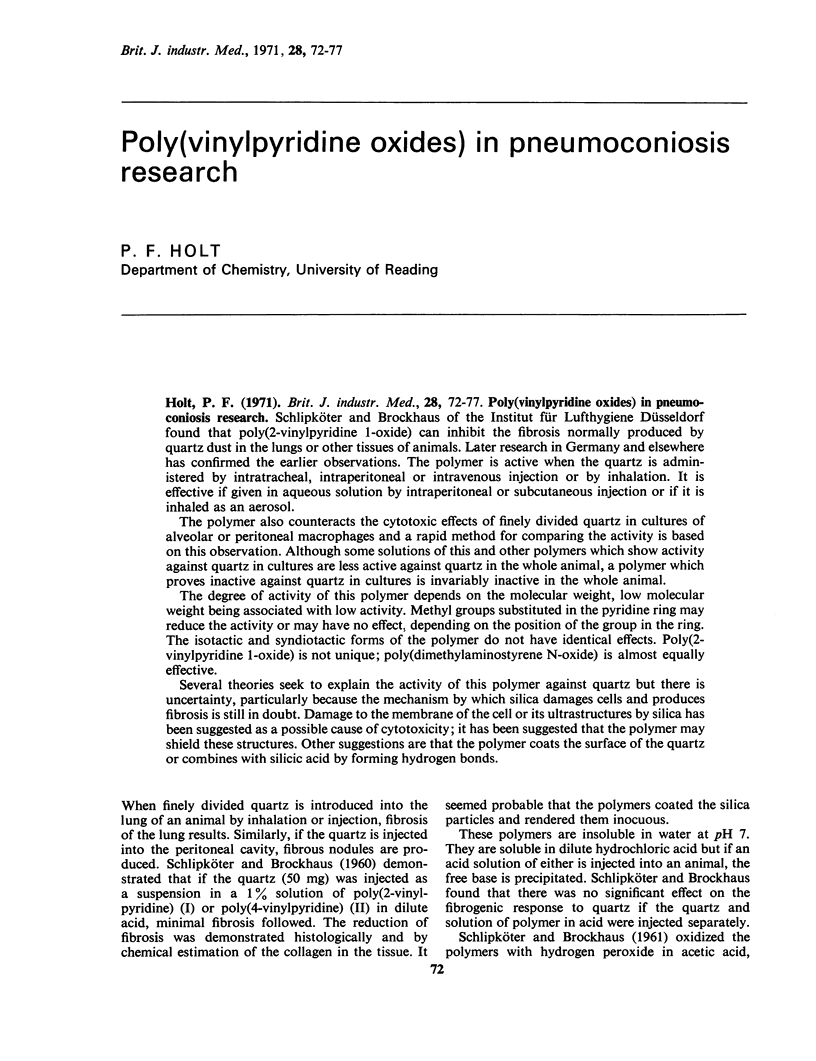
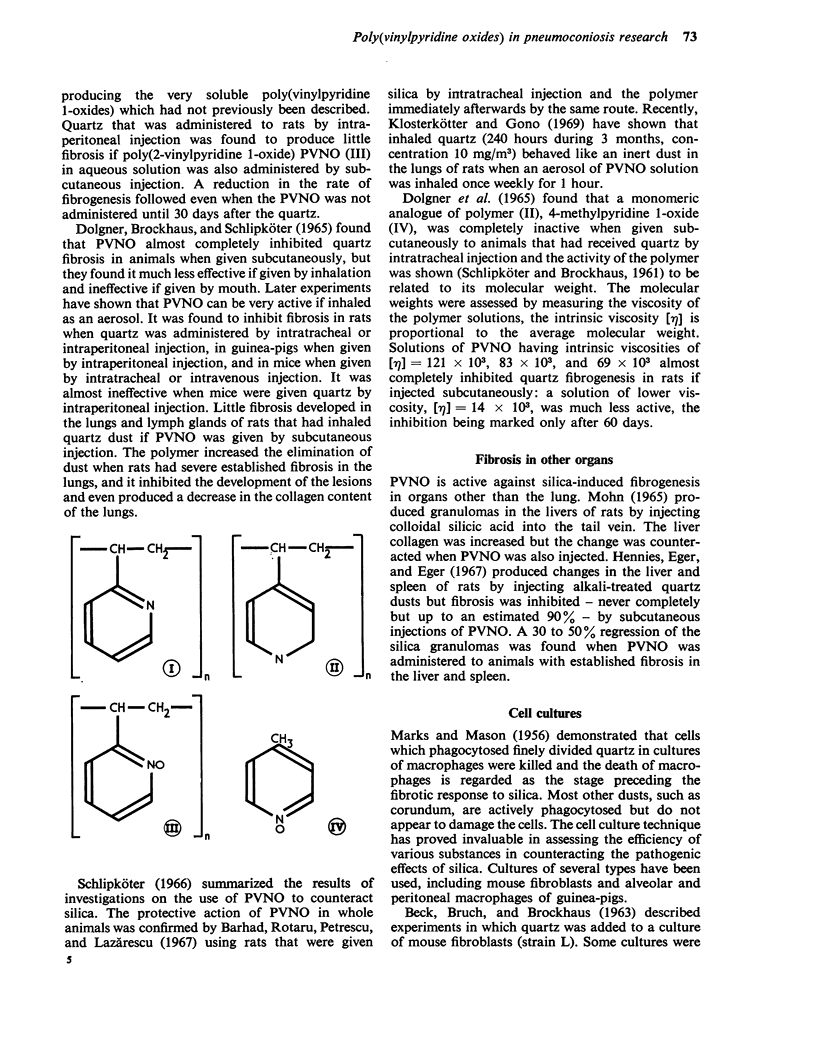
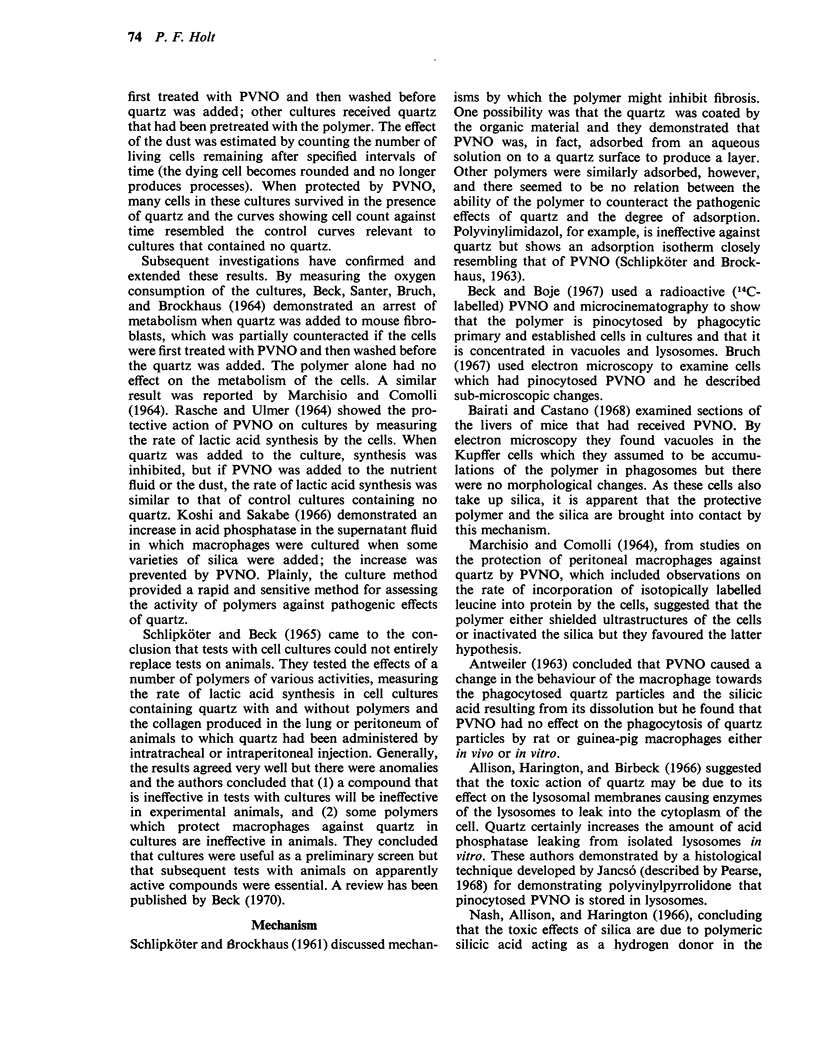
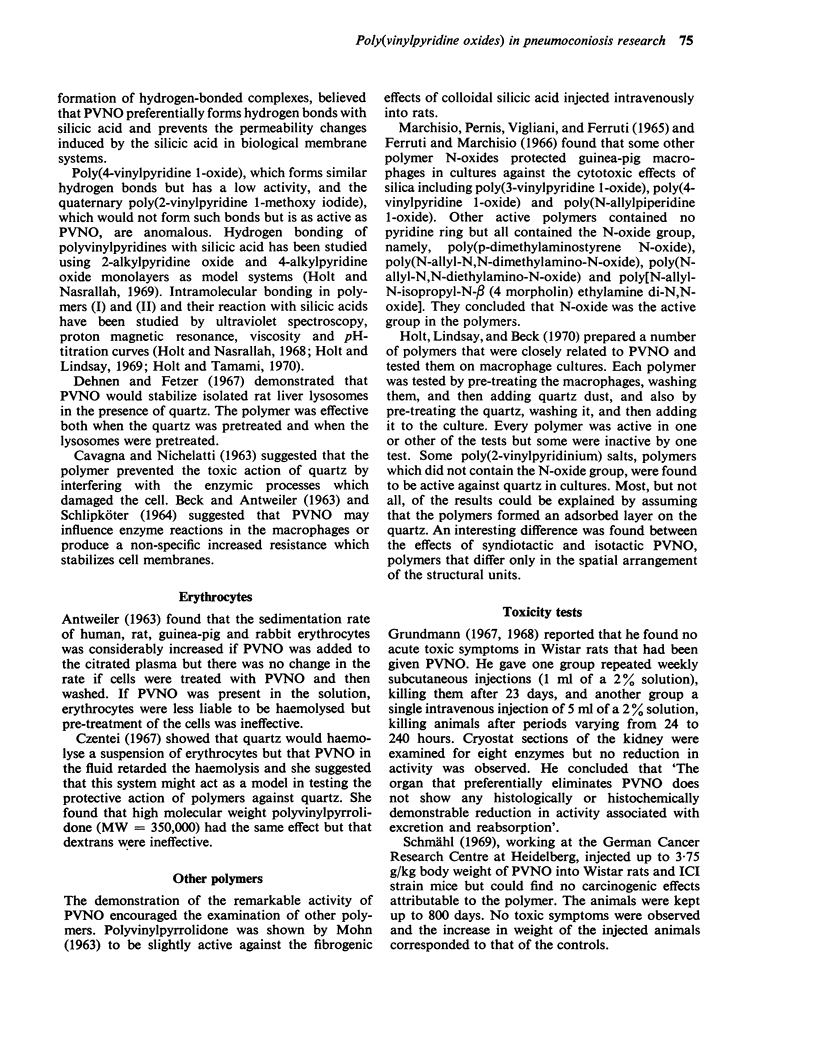
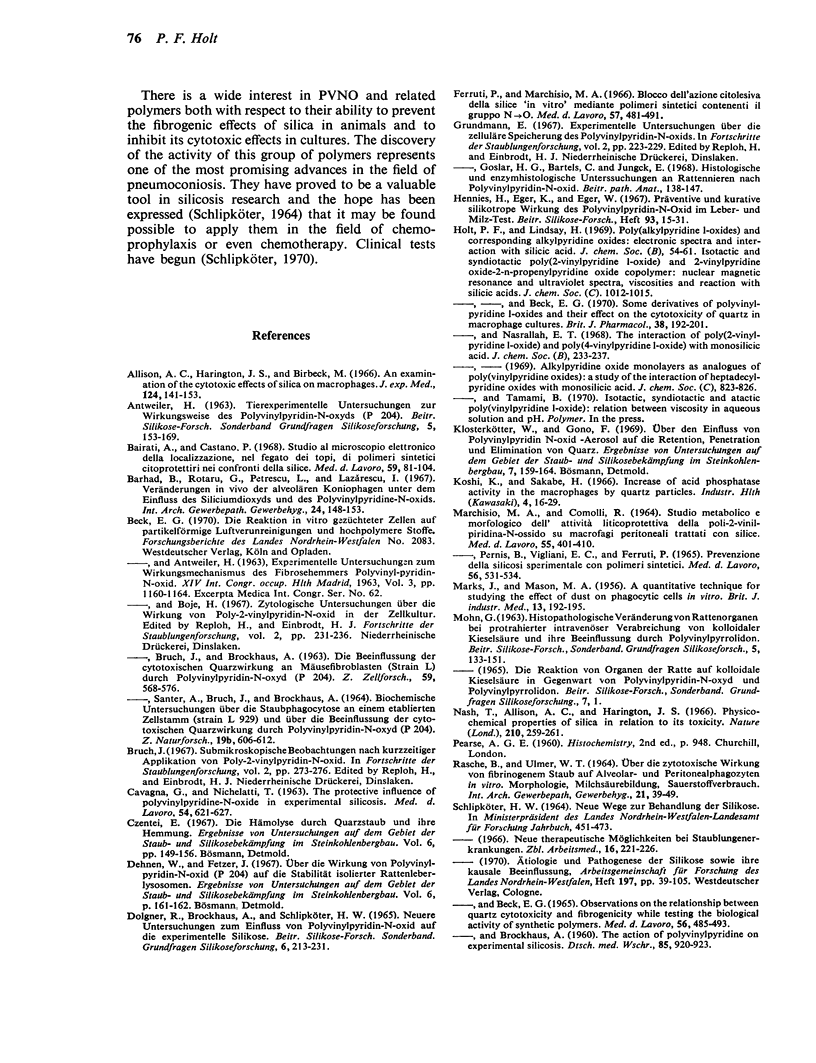

Selected References
These references are in PubMed. This may not be the complete list of references from this article.
- Allison A. C., Harington J. S., Birbeck M. An examination of the cytotoxic effects of silica on macrophages. J Exp Med. 1966 Aug 1;124(2):141–154. doi: 10.1084/jem.124.2.141. [DOI] [PMC free article] [PubMed] [Google Scholar]
- BECK E. G., SANTER A., BRUCH J., BROCKHAUS A. BIOCHEMISCHE UNTERSUCHUNGEN UEBER DIE STAUBPHAGOCYTOSE AN EINEM ETABLIERTEN ZELLSTAMM (STRAIN L 929) UND UEBER DIE BEEINFLUSSUNG DER CYTOTOXISCHEN IUARZWIRKUNG DURCH POLYVINYLPYRIDIN-N-OXID (P 204) Z Naturforsch B. 1964 Jul;19:606–612. [PubMed] [Google Scholar]
- Bairati A., Castano P. Studio al microscopio elettronico della localizzazione, nel fegato dei topi, di polimeri sintetici citoprotettivi nei confronti della silice (poli-vinilpriridiana-N-ossido e poli-p-dimetilamminostirolo-N-ossido) Med Lav. 1968 Feb;59(2):81–104. [PubMed] [Google Scholar]
- Barhad B., Rotaru G., Petrescu L., Lăzărescu I. Veränderungen "in vivo" der alveolären Koniophagen unter dem Einfluss des Siliciumdioxyds und des Polyvinylpyridin-N-oxyds. Int Arch Arbeitsmed. 1967;24(2):148–153. [PubMed] [Google Scholar]
- Cavagna G., Nichelatti T. The protective influence of polyvinylpyridine-N-oxide in experimental silicosis. Med Lav. 1963 Oct;54(10):621–627. [PubMed] [Google Scholar]
- DOLGNER R., BROCKHAUS A., SCHLIPKOETER H. W. NEUERE UNTERSUCHUNGEN ZUM EINFLUSS VON POLYVINYLPYRIDIN-N-OXID AUF DIE EXPERIMENTELLE SILIKOSE. Grundfragen Silikoseforsch. 1963;6:213–231. [PubMed] [Google Scholar]
- Ferruti P., Marchisio M. A. Blocco dell'azione citolesiva della silice "in vitro" mediante polimeri sintetici contenenti il gruppo N-O. Med Lav. 1966 Aug-Sep;57(8):481–491. [PubMed] [Google Scholar]
- Grundmann E., Goslar H. G., Bartels C., Jungck E. Histologische und enzymhistochemische Untersuchungen an Rattennieren nach Polyvinylpyridin-N-oxid. Beitr Pathol Anat. 1968;138(1):134–147. [PubMed] [Google Scholar]
- Holt P. F., Lindsay H., Beck E. G. Some derivatives of polyvinylpyridine 1-oxides and their effect on the cytotoxicity of quartz in macrophage cultures. Br J Pharmacol. 1970 Jan;38(1):192–201. doi: 10.1111/j.1476-5381.1970.tb10347.x. [DOI] [PMC free article] [PubMed] [Google Scholar]
- MARKS J., MASON M. A. A quantitative technique for studying the effect of dust on phagocytic cells in vitro. Br J Ind Med. 1956 Jul;13(3):192–195. doi: 10.1136/oem.13.3.192. [DOI] [PMC free article] [PubMed] [Google Scholar]
- Marchisio M. A., Pernis B., Vigliani E. C., Ferruti P. Prevenzione della silicosi sperimentale con polimeri sintetici. Med Lav. 1965 Aug-Sep;56(8):531–534. [PubMed] [Google Scholar]
- Nash T., Allison A. C., Harington J. S. Physico-chemical properties of silica in relation to its toxicity. Nature. 1966 Apr 16;210(5033):259–261. doi: 10.1038/210259a0. [DOI] [PubMed] [Google Scholar]
- SCHLIPKOETER H. W., BROCKHAUS A. [The effects of polyvinylpyridine on experimental silicosis]. Dtsch Med Wochenschr. 1960 May 20;85:920–923. doi: 10.1055/s-0028-1112521. [DOI] [PubMed] [Google Scholar]
- Schlipköter H. W., Beck E. G. Observations on the relationship between quartz cytotoxicity and fibrogenicity while testing the biological activity of synthetic polymers. Med Lav. 1965 Jun-Jul;56(6):485–493. [PubMed] [Google Scholar]
- Schmähl D. Prüfung von Polyvinylpyridin-N-oxid (PVNO) auf carcinogene Wirkung bei Ratten und Mäusen. Arzneimittelforschung. 1969 Aug;19(8):1313–1314. [PubMed] [Google Scholar]


